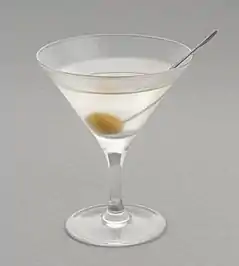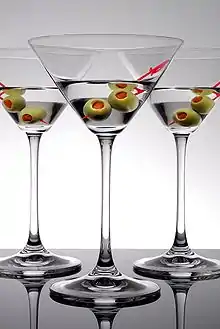Martini (cocktail)
The martini is a cocktail made with gin and vermouth, and garnished with an olive or a lemon twist. Over the years, the martini has become one of the best-known mixed alcoholic beverages.
| IBA official cocktail | |
|---|---|
 The martini is one of the most widely known cocktails | |
| Type | Cocktail |
| Primary alcohol by volume | |
| Served | Up (or on the rocks) |
| Standard garnish | Olive or lemon twist |
| Standard drinkware | |
| IBA specified ingredients | |
| Preparation | Straight: Pour all ingredients into mixing glass with ice cubes. Stir well. Strain into chilled martini cocktail glass. Squeeze oil from lemon peel onto the drink, or garnish with olive. |
| Timing | Before dinner |
H. L. Mencken called the martini "the only American invention as perfect as the sonnet",[1] and E. B. White called it "the elixir of quietude".[2]
Preparation

By 1922 the martini reached its most recognizable form in which London dry gin and dry vermouth are combined at a ratio of 2:1, stirred in a mixing glass with ice cubes, with the optional addition of orange or aromatic bitters, then strained into a chilled cocktail glass.[3] Over time the generally expected garnish became the drinker's choice of a green olive or a twist of lemon peel.
A dry martini is made with dry, white vermouth. By the Roaring Twenties, it became a common drink order. Over the course of the 20th century, the amount of vermouth steadily dropped. During the 1930s the ratio was 3:1 (gin to vermouth), and during the 1940s the ratio was 4:1. During the latter part of the 20th century, 6:1, 8:1, 12:1, 15:1 (the "Montgomery", after British Field Marshal Bernard Montgomery's supposed penchant for attacking only when in possession of great numerical superiority),[4] or even 50:1 or 100:1 Martinis became considered the norm.[5]
A wet martini contains more vermouth; a 50-50 martini uses equal amounts of gin and vermouth. An upside-down or reverse martini has more vermouth than gin.
A dirty martini contains a splash of olive brine or olive juice and is typically garnished with an olive.[6]
A perfect martini uses equal amounts of sweet and dry vermouth.[7]
Some martinis were prepared by filling a cocktail glass with gin, then rubbing a finger of vermouth along the rim. There are those who advocated the elimination of vermouth altogether. Luis Buñuel used the dry martini as part of his creative process, regularly using it to sustain "a reverie in a bar". He offers his own recipe, involving Angostura bitters, in his memoir.[8]
In 1966, the American Standards Association (ASA) released K100.1-1966, "Safety Code and Requirements for Dry Martinis", a tongue-in-cheek account of how to make a "standard" dry martini.[9] The latest revision of this document, K100.1-1974, was published by American National Standards Institute (ANSI), the successor to ASA, though it is no longer an active standard.[10]
Variations
The traditional martini comes in a number of variations. The fictional spy James Bond sometimes asked for his vodka martinis, which substitute vodka for gin, to be "shaken, not stirred" (although, in books by Ian Fleming, Bond asks for "stirred, not shaken"), following Harry Craddock's The Savoy Cocktail Book (1930), which prescribes shaking for all its martini recipes.[11] The proper name for a shaken martini is a Bradford;[12] however, Somerset Maugham is often quoted as saying that "a martini should always be stirred, not shaken, so that the molecules lie sensuously on top of one another."[13] In Casino Royale, Fleming invented the Vesper martini, with gin, vodka, and Kina Lillet.
A porn star martini is a popular variation of a vodka martini. Traditionally, the vodka is vanilla flavoured, and is mixed with Passoã and passion-fruit juice before being served in a martini glass, accompanied by a shot glass filled with prosecco.[14]
A martini may also be served on the rocks; that is, with the ingredients poured over ice cubes and served in an old fashioned glass.[15] This, like a martini shaken with ice, will dilute the drink.
A Gibson is a standard dry martini garnished with cocktail onions instead of olives. It was invented at the Bohemian Grove Club in San Francisco in 1907.
Total variations
Sometimes the term "martini" is used to refer to other mostly-hard-liquor cocktails such as Manhattan, Cosmopolitan, and ad hoc or local concoctions whose only commonality with the drink is the cocktail glass in which they are served. Chefs with a more whimsical bent are even producing dessert martinis which are not a drink at all, but are merely served in martini glasses.
Another popular form is the espresso martini, popular in restaurants as a dessert. Many variations exist but most involve shaking an espresso shot with the ingredients and served in a chilled martini glass. By shaking a fresh espresso shot it creates a hard layer of crema which is garnished with three coffee beans in the centre.[16]
It is important to note, however, that since these things not are gin/vodka and vermouth, they are not actually martinis, they are merely other things being served in martini glasses.
Origins and mixology
The exact origin of the martini is unclear. The name may derive from the Martini brand of vermouth.[17] Another popular theory suggests it evolved from a cocktail called the Martinez served sometime in the early 1860s at the Occidental Hotel in San Francisco, which people frequented before taking an evening ferry to the nearby town of Martinez, California. Alternatively, residents of Martinez say a bartender in their town created the drink,[18][19] while another source indicates that the drink was named after the town. Indeed, a "Martinez Cocktail" was first described in Jerry Thomas's 1887 edition of his Bartender's Guide, How to Mix All Kinds of Plain and Fancy Drinks:[20]
- Take 1 dash of Boker's bitters
- 2 dashes of Maraschino
- 1 pony [1 fl oz] of Old Tom gin
- 1 wine-glass [2 fl oz] of [sweet/Italian] vermouth
- 2 small lumps of ice
- Shake up thoroughly, and strain into a large cocktail glass. Put a quarter of a slice of lemon in the glass, and serve. If the guest prefers it very sweet, add two dashes of gum syrup.
Other bartending guides of the late 19th century contained recipes for numerous cocktails similar to the modern-day martini.[21] For example, Harry Johnson's Bartenders' Manual (1888) listed a recipe for a “Martini Cocktail” that consisted in part of half a wine glass of Old Tom gin and a half a wine glass of vermouth.[22]
- Fill the glass up with ice
- 2 or 3 dashes of gum syrup
- 2 or 3 dashes of bitters; (Boker's genuine only)
- 1 dash of Curaçao
- 1⁄2 wine glassful [1 fl oz] of Old Tom gin
- 1⁄2 wine glassful [1 fl oz] of [sweet/Italian] vermouth
- Stir up well with a spoon, strain it into a fancy cocktail glass, squeeze a piece of lemon peel on top, and serve.
The first dry martini is sometimes linked to the name of a bartender who concocted the drink at the Knickerbocker Hotel in New York City in 1911 or 1912.[23] The "Marguerite Cocktail", first described in 1904, could be considered an early form of the dry martini, because it was a 2:1 mix of Plymouth dry gin and dry vermouth, with a dash of orange bitters.[24]
During Prohibition in the United States, during the mid-20th century, the relative ease of illegal gin manufacture led to the martini's rise as the locally predominant cocktail. With the repeal of Prohibition, and the ready availability of quality gin, the drink became progressively drier. In the 1970s and '80s, the martini came to be seen as old-fashioned and was replaced by more intricate cocktails and wine spritzers, but the mid-1990s saw a resurgence in the drink and numerous new versions.[25]
Some newer drinks include the word "martini" or the suffix "-tini" in the name (e.g., appletini, peach martini, chocolate martini, breakfast martini, espresso martini). These are so named because they are served in a martini cocktail glass. Generally containing vodka, they share little in common with the martini.
See also
References
- Edmunds, Lowell (1998). Martini, Straight Up: The Classic American Cocktail (Revised ed.). Johns Hopkins University Press. ISBN 9780801859717. LCCN 98018257.
- Conrad, Barnaby, III (1995). The Martini: An Illustrated History of an American Classic. Chronicle Books. pp. 10–11. ISBN 9780811807173. LCCN 94017325.
- McElhone, Harry (1922). Harry's ABC of Mixing Cocktails (PDF). Dean & Son. p. 67.
- John Taylor (19 October 1987). "The Trouble With Harry's". New York Magazine. p. 62.
- "Drink Recipes: How to Make a Dry Martini, Classic Cocktails". Thirsty NYC. 6 February 2014. Archived from the original on 6 February 2014. Retrieved 6 February 2014.
- Bloom, Dave (2003). The Complete Bartender's Guide. Carlton Books. p. 95. ISBN 1-84222-736-X.
- "Making the Perfect Martini".
- Buñuel, Luis (1982). Mon Dernier soupir [My Last Breath] (in French).
- K100.1-1966 Safety Code and Requirements for Dry Martinis (PDF) (1966 ed.). American Standards Association. 31 August 1966. Retrieved 21 February 2016.
- K100.1-1974 Safety Code and Requirements for Dry Martinis (PDF) (1974 ed.). American National Standards Institute. 30 August 1974. Archived from the original (PDF) on 26 December 2015. Retrieved 21 February 2016.
- Craddock, Harry (2011). The Savoy Cocktail Book. Pavilion Books. pp. 102–103. ISBN 978-1-86205-296-3.
- David A. Embury (1948). The Fine Art of Mixing Drinks. New York City: Doubleday. p. 101.
- Schott, Ben (2003). Schott's Food & Drink Miscellany. London: Bloomsbury Publishing. ISBN 978-0-7475-6654-0.
- Abraham, Lena (12 October 2018). "Porn Star Martinis". Delish.com. Retrieved 29 August 2019.
- Irma S. Rombauer (1975). Joy of Cooking. p. 49.
[The old-fashioned glass] is increasingly used these days [mid-1970s] by people who prefer their martini 'on the rocks' instead of 'up'—that is, in the rather more fussy and more precise cocktail-glass type of preparation.
- Cloak, Felicity (28 December 2016). "How to make the perfect espresso martini". The Guardian. London, England. Retrieved 27 January 2017.
- Martini at the online etymology dictionary
- Taylor, David (2002). Martini. Silverback Books. p. 8. ISBN 978-1-930603-03-5.
- "The Martini Story". cityofmartinez.org. City of Martinez. Retrieved 14 July 2013.
- Thomas' 1887 "Martinez Cocktail" recipe.
- Edmunds, Lowell (1998). Martini, Straight Up: The Classic American Cocktail. Johns Hopkins University Press. p. 81. ISBN 978-0-8018-7311-9.
- Johnson, Harry (1888). The New and Improved Illustrated Bartenders' Manual; Or: How to Mix Drinks of the Present Style. H. Johnson. p. 38.
- Gasnier, Vincent (2007). Drinks. DK Adult. p. 376.
- Thomas, Stuart (1904). Stuart's Fancy Drinks and How to Mix Them. Excelsior Publishing House. p. 132.
- "Shaken or Stirred? A Short History to Celebrate National Martini Day". The Drink Nation. 19 June 2012. Retrieved 19 July 2012.
External links
| Wikimedia Commons has media related to Martini (cocktail). |
| The Wikibook Bartending has a page on the topic of: Cocktails/Martini |
- Gadberry, Brad (12 January 2008). "The Martini FAQ". Retrieved 10 August 2008.